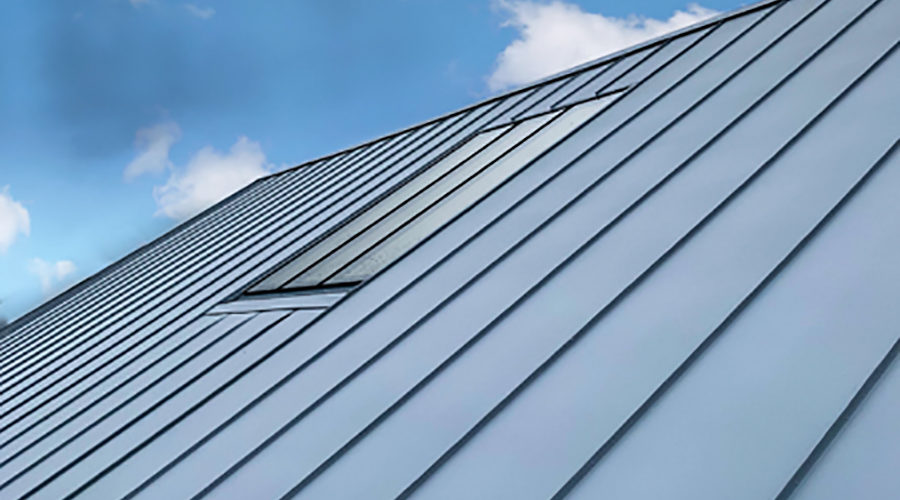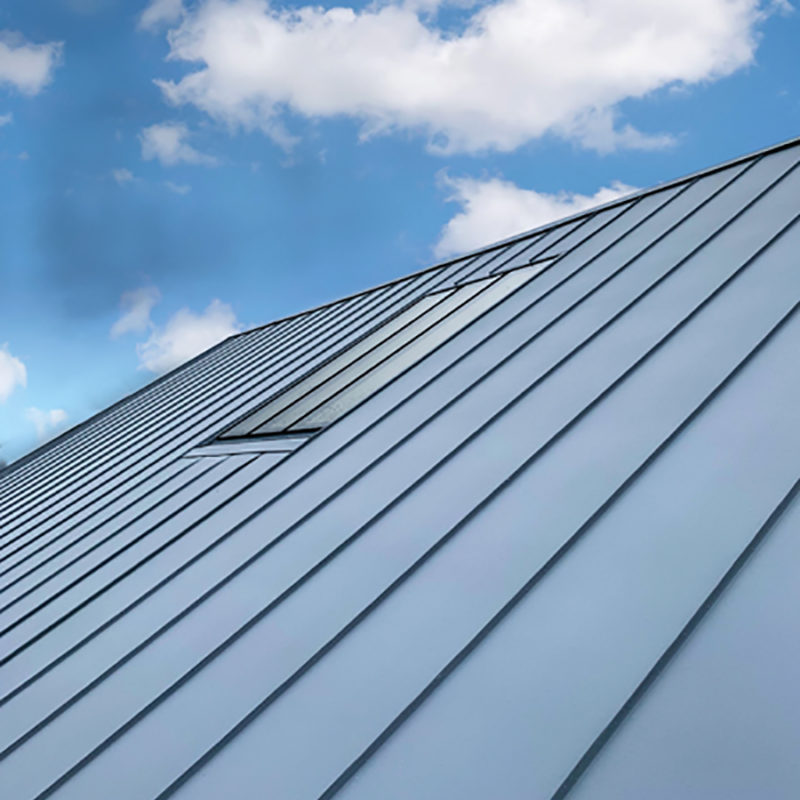Paul Trace from Stella Rooflight offers some advice on the use of rooflights in zinc roofs.
Stella Rooflight
Despite being used for over 200 years, zinc roofs have hit their prime. Versatile, robust and with multiple colours and styling options, they are an architect’s dream. What’s more, with a growing focus on sustainability in design, zinc is a 100% recyclable material that is also energy efficient to produce. With so many benefits, zinc roofing is an attractive proposition for properties.
However, often architects will talk about the trade-off you may have to make with a zinc roof. For example, many architects may steer away from zinc if you are planning to add rooflights. Similarly, architects might focus on other natural light options if a zinc roof is the right choice for your property. However, does there always have to be a trade-off? Here, we uncover the myths around rooflights and zinc roofs and offer some top tips to ensure you can achieve the best of both worlds.
Why is zinc roofing so popular?
With its contemporary styling, it’s hard to believe that zinc has been used in roofing for centuries. However, it’s the contemporary appearance that is really allowing zinc to grow in popularity. Whereas some roofing material will mean compromising your building materials, zinc offers a huge variety of colours and finishes so that it can work in harmony with almost any structure.
This versatility makes zinc ideal for a range of roofing projects. For example, agricultural projects, converted barns as well as listed or protected buildings, such as those in conservation areas. Zinc colours can blend or contrast with the building, while different textures, such as ripples, grooves and scales, can help enhance the aesthetic.
Ready for weather and the next 100 years
As well as the design and aesthetics, a zinc roof offers longevity. It has excellent weatherproof properties and is UV resistant. This ability to withstand harsh conditions adds to the lifespan of a zinc roof, as does the ability to resist corrosion. In fact, some describe zinc as self-healing as it has an unusual ability to repair itself over time when it comes to surface scratches.
All of this combined means that zinc roofing can have a long-term serviceable life. In some cases, zinc roofing can last for up to 100 years. What’s more, during such a long lifespan, the maintenance requirement is minimal. The most important maintenance is to clear debris, such as fallen leaves, and ensure the zinc is treated where necessary.
Can you install rooflights in a zinc roof?
There are several concerns when it comes to installing rooflights on a zinc roof. One is the fact that rooflights can tend to look bulky on a zinc roof. This is especially apparent as a zinc roof can have an ultra-thin profile. The fact that many rooflights can have a bulkier frame can deter architects and property owners.
When there is an overlap or large seam, there is also a potential problem with heavy rainfall. A thicker rooflight profile can increase the risk of water ingress. This can also be exacerbated when the roof pitch is low. Without a high angle to promote water runoff, there is a risk that water will pool at the top of the rooflight. This may be fine in the short term but may cause long-term issues, especially if the water finds a way into the roof.
The way to get around this is to opt for rooflights that can fit flush against the roof. Having an ultra-thin frame that sits flush against the roof can help prevent the risk of water ingress while also offering a more pleasing aesthetic and maintaining the clean lines of the roof.
Zinc roof rooflights: key considerations
If you’re looking to incorporate rooflights into a zinc roof, there are factors to consider to ensure it is a success:
1. Design
A zinc roof is often chosen because of its aesthetic. The installation of a rooflight, particularly bulky rooflights, can be unsightly on the streamlined, thin profile of a zinc roof.
Often, zinc roofing is used in conservation areas as it can work sympathetically with slate roofing. However, for rooflights to be approved by conservation building officers, it is crucial for the rooflights to be part of the seamless design of the roof. A subtle design is essential, and this is best achieved by using rooflights that sit flush against the roof so they are barely detectable.
A thin, but durable, frame of the rooflight can help to ensure that they meet the needs of a conservation plan and is in keeping with the sleek design of the roof.
2. Roof pitch
As mentioned above, the pitch of the roof can be a significant consideration when installing a rooflight. A low pitch (roof angle) can mean that the water doesn’t run off with ease. As a result, more standing water on the roof can lead to water ingress, and the seams around the rooflight can cause capillary action to draw water into the roof construction.
The most successful rooflight installation will be in properties with a significant roof pitch. Ideally, a pitch would be above 14° as capillary action is more likely in an angle less than this.
If you have a low roof pitch, then it is still possible to install rooflights. However, it becomes more important to opt for rooflights with a thin profile to prevent the build-up of water around the frame or head of the rooflight. You can also help to mitigate the risk of water ingress by installing a gully around the rooflight to improve drainage and reduce the amount of water that flows over the top of the rooflight’s surface.
3. Width and seams
Another key consideration is the width of the rooflight. Naturally, many property owners appreciate large rooflights that let in as much natural light as possible. However, large rooflights on a zinc roof can cause issues with water ingress.
A rooflight will typically be installed across seams in the roof. However, the more seams that a rooflight crosses means that more water has to be diverted further. This water diversion can cause puddling or pooling, increasing the risk of water build-up and ingress without the roof materials.
Generally, it is recommended that rooflights should not cross more than three seams in a zinc roof. This is an important design and lighting consideration when working out the maximum width of the rooflights.
Stainless-steel, ultra-thin rooflights for zinc roofs
Stella rooflights are an architect’s favourite for zinc roofing, due to their strong and durable construction and ultra-thin stainless-steel profile. Stella stainless-steel slim rooflights sit flush against the roof, helping to improve the aesthetics, meet the needs of conservation regulations and reduce the risk of water issues too.
All Stella rooflights are bespoke made for each project and can, therefore, be designed to fit any size or shape required, with a wide range of custom options available.
In addition, much like a zinc roof, Stella’s stainless-steel rooflights offer unrivalled longevity and will not rust, unlike mild- or carbon-steel-framed alternatives. A Stella rooflight is the ideal choice to complement a zinc roof application however big or small.










1 Comment
Pingback: Discover How Long Does a Metal Roof Last
Comments are closed.